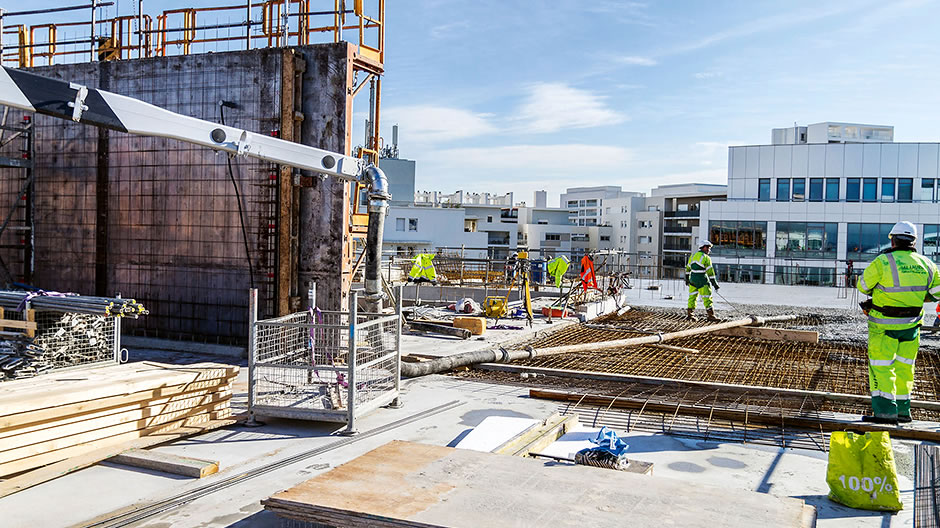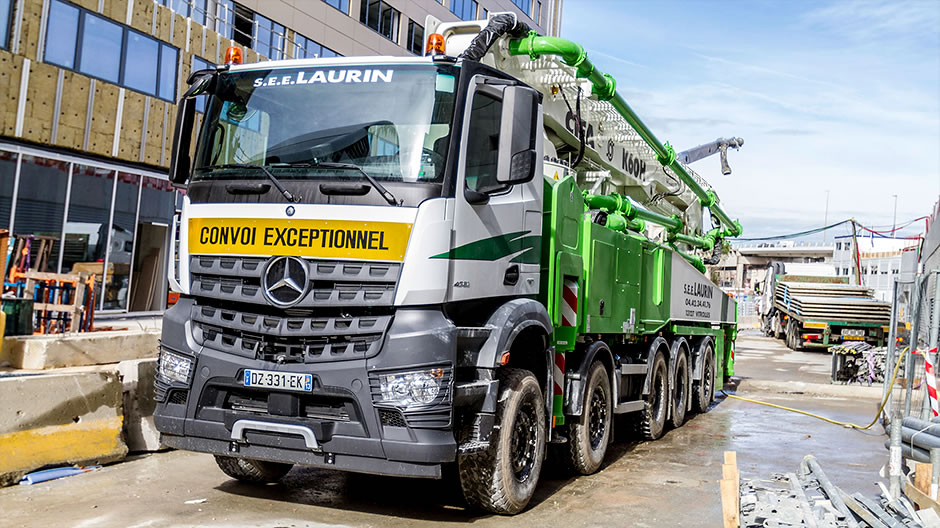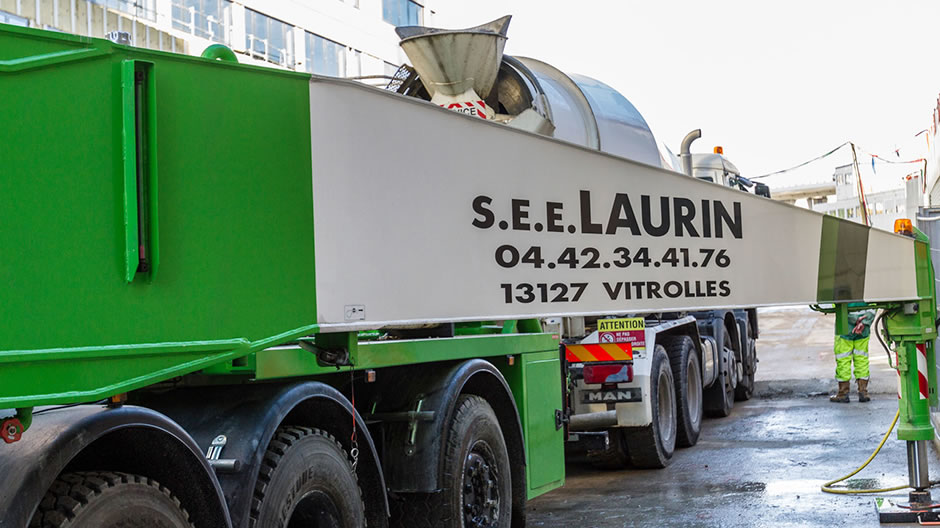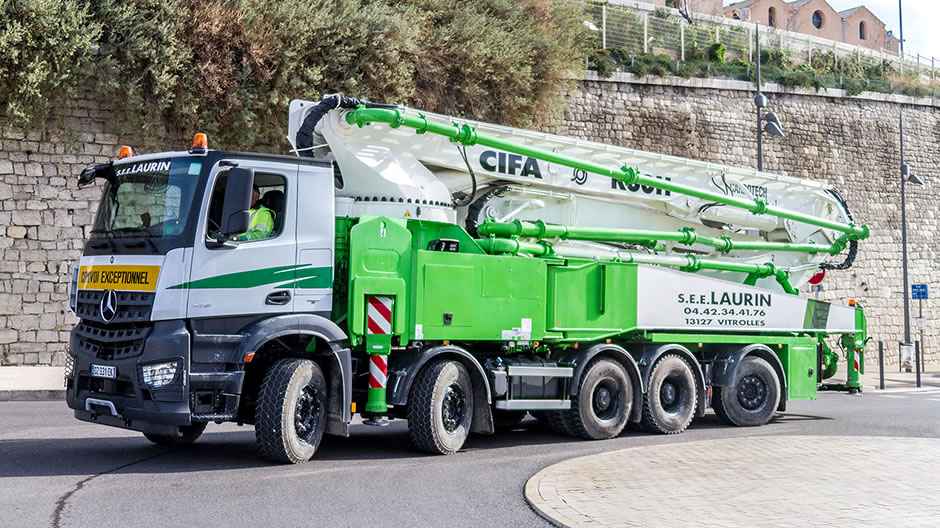
S.E.E. Laurin and their concrete pump truck on an Arocs chassis
Economics & Logistics
With a 60-metre distribution mast, Gérard Laurin's concrete pump truck is unique in France. Mounted on an Arocs chassis, it is intended to be in operation for between 15 and 18 years.

Above the skyline of Marseille. In the last-but-one floor of a new office block, workers are currently pouring a concrete floor.
Near to the CMA CGM Tower opposite Marseille's Port de La Joliette, construction work is in full swing. Immense construction sites are lined up seamlessly next to one another. In the thick of things is a five-axle Arocs 4751 with a huge concrete pump. Its fifth axle is a steered axle which allows the 13.4-metre-long vehicle to easily manoeuvre in tight spaces. But before the pump can be brought into action, the supports with their hydraulic cylinders first need extending. Viewed from above, they resemble spiders' legs. And anyone who wishes to follow the 60-metre mast with their eyes has to stretch their neck immensely …
“My concrete pump is currently the only one of its kind in France. But the competition will surely react: we'll be the ones creating the demand with the customers.”
Gérard Laurin, owner of S.E.E. Laurin
Gérard Laurin, the proud owner of this concrete pump, is standing in the last-but-one floor of the new-build, remote control in hand. Today, the concrete for the floor will be poured. 20 m below the boss of S.E.E. Laurin, the Arocs waits patiently for the next concrete mixer to dock from behind onto the funnel of the pump machine. Gérard Laurin starts the pump and watches the workers as they guide the end-piece of the pipe to the metal grid at the position where the concrete is needed. “As soon as they stop working, I have to stop the pump immediately,” he says.
As Gérard Laurin explains, a concrete pump truck is more than just a truck: it's a work machine which is exempt from road tax. Despite its 60-metre-long distribution mast, the vehicle is only 4 m high in its drivable state. The theoretical delivery capacity is 180 m³ per hour and the maximum delivery pressure at the end of the pipe is 83 bar. “My concrete pump is currently the only one of its kind in France. But the competition will surely react: we'll be creating the demand with the customers,” anticipates Gérard Laurin.

22 percent of concrete poured in France comes out of a concrete pump. Countries such as Switzerland, Italy or The Netherlands have a higher share at 70 %.
Besides a couple of dozen concrete pumps, the boss of the company based in Vitrolles also has his own concrete mixers. Accordingly, he knows what he's talking about. In the year 2000, he was the first person in the region to acquire a pump with a 42-metre-long distribution mast. Then he took delivery of one with a mast length of 52 m. In China, pumps with distribution masts bigger than 100 m are already apparently in operation.
In France, things haven't quite gotten that far. Construction companies still prefer working with cranes and concrete silos. “But it's actually better to use a pump, rather than concreting manually,” says Gérard Laurin, shaking his head in disbelief at the alternative. “Here, in the south of France, we're privileged, because we can pump 26 % of the concrete manufactured; elsewhere in the country, that figure is 22 %.” A somewhat lacklustre number compared with other European countries like Switzerland, Italy and The Netherlands, where 70 % of concreting jobs are carried out with the help of a pump. “Even in Morocco concrete pump trucks are used more frequently than here.”
The somewhat higher percentage for southern France comes from the fact that the local concrete manufacturers don't just handle the production and the transport, but that they also have pumps available to them. For the construction of swimming pools, the company also prefers to use concrete pump trucks. “We also work in the field of underground construction, building for example bridges or forms for ship construction in dry docks,” explains Gérard Laurin.

The new concrete pump truck is the first one which S.E.E. Laurin ordered from Italian manufacturer CIFA. And the investment costs one million euros. In order to save weight, the final three elements of the distribution mast are manufactured in carbon fibre, offering a construction which, despite being 30 % more expensive than an equivalent steel version, has the advantage of not rusting, of being lighter and also being more rigid.
Despite that, the pump requires regular maintenance, which is carried out like all other maintenance work at the company's own workshop in Vitrolles. Wear parts, seals, filters and hydraulic oil have to be changed regularly. That's because the fine concrete particles, which unavoidably enter the hydraulics circuit lead to a higher level of material wear. “We have to be proactive in our approach: if we start getting problems on building sites with the pipes and there's concrete in the mast, that's not good news,” says Gérard Laurin. That's why all pipes have to be cleaned on-location after each operation – this prevents concrete from hardening inside them.

Kompakte Abmessungen. Im fahrbereiten Zustand ist die Autobetonpumpe von S.E.E. Laurin keine vier Meter hoch. Der Unternehmer hat sich vor allem wegen seiner Robustheit und seines Komforts für den Arocs entschieden.
Thanks to such preventive and pro-active maintenance work, Gérard Laurin can use his vehicles for between 15 and 18 years. He's been in the business for almost 30 years and has now accrued extensive knowledge about mechanics and hydraulics, such that he can now even carry out a number of maintenance tasks himself. “What I do, I do with passion. I don't mind in the slightest,” he continues.
Even the drivers of his concrete pump truck have to share this enthusiasm, as they also bear great responsibility. They decide on-location as to whether the safety and technical conditions for using their machine are fulfilled. If this is not the case, they may refuse the assignment. The construction sites are often far away from the company's headquarters, with tours taking drivers to the departments of Bouches-du-Rhône, Gard and Vaucluse. With an average of 50,000 km per year, the concrete pump trucks stack up an impressively high mileage.
Even this new 44.7-tonne machine based on the Arocs chassis is no different. For Gérard Laurin, the comfort of the Arocs cab is a major argument in favour of his latest decision for a vehicle from Mercedes-Benz.
Contact.
Gérard Laurin, S.E.E. Laurin.
Tel. no.: +33 (0)4 42 34 41
76
E-mail: laurin.see@orange.fr
Daniel Krupka, Mercedes-Benz France.
Tel. no.: +33 (0)1 30 05
85 84
E-mail: daniel.krupka@daimler.com
Photos: Hans Müller




Comment
Please log in to post a comment.
No comments yet